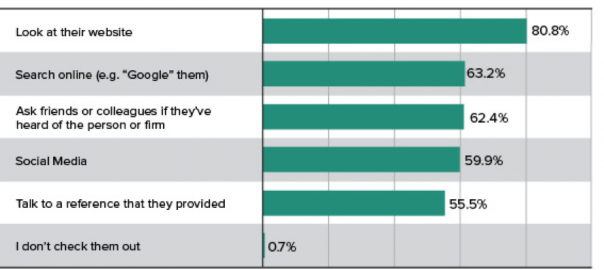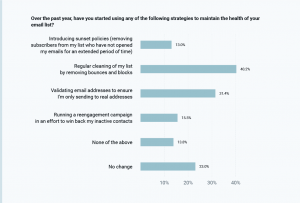In professional services marketing, it’s likely that at one time or another, many of your clients discovered your firm through face-to-face networking. The importance of networking has not gone away. However, as digital marketing has outgrown traditional marketing in certain ways, social media platforms have revolutionized networking by providing online venues for building relationships and demonstrating thought leadership.
Our research on 1,028 professional services buyers shows that six in ten now turn to social media to check out firms before they purchase. Amazingly, it also reveals that social media presence is now even more critical than client references.
If you haven’t yet dabbled in social media or are just taking your first steps into it, you may feel uncomfortable with these facts. After all, they reveal an inconvenient truth—if you want to grow your business, it’s time to get serious about social media marketing.
LinkedIn for Business Development: Getting Started
So, how should you get started? Long-term you’ll discover that layering several social media platforms together will give you the best results. However, it’s best to begin with a solid foundation on the one social media platform that matters most for professional service firms—LinkedIn. That’s because it’s populated by educated professionals sharing the latest ideas.
After building a strong LinkedIn profile for each of your key business development team members, use the following three steps as a guide:
1) Participate in LinkedIn Groups
You will meet people who have shared professional interests by joining LinkedIn groups. Before choosing groups, decide who in your target audience you want to reach. Remember, in B2B sales there are usually multiple people who influence the buying decision.
You want to find groups that appeal to each of the people who play a role in the decision-making process, broadening your reach. For example, if your firm helps both sales and marketing professionals, you may need to join both the ‘Sales Best Practices’ group and the ‘Content Strategy’ group.
To discover the groups in which your decision-makers and influencers participate, look at the profiles of clients and prospects. Often they will list the groups to which they belong. Check out these groups to determine which ones are the most active. The more discussions that are in progress, the more likely it is that you’ll be able to find ones to which you can add value and show your thought leadership and meet new prospects.
You can get your feet wet in a group by answering questions or commenting on topics other group members have raised. Alternatively, to gain even greater visibility, you can initiate a discussion.
Just as in live networking, leading a discussion with a sales pitch will put a quick end to conversations. So, if you link to content to start a conversation don’t be self-promotional. Instead, mix other blog posts and articles in with content your firm produces. A good guideline is four pieces of content curated from other sources to one of your own.
By bringing up hot topics and discussing the key issues your prospects and clients are grappling with, you can establish your firm’s management as thought leaders, showing your expertise.
SEE ALSO: 3 Ways High Growth Firms Use LinkedIn Groups to Increase Visibility, Connections and Lead Generation
2) Drive Traffic from LinkedIn to Your Website
There are several ways that LinkedIn can also drive traffic to your site without spending a dime. And we have seen that more traffic leads to more conversions (folks downloading content and filling out contact forms, for example), which results in more new business opportunities. Let’s take a look:
- First, visitors may be directed to your website from the group discussions. At Hinge, we’ve seen this tactic drive a significant amount of new LinkedIn traffic to our website.
- Second, when someone completes a search for a professional who can help them to solve a problem, one of your company’s leaders may rise to the top of the search results. If his or her profile includes a link to your website in the ‘Contact Info’ section, as it should, the searcher is just one click away from your site.
- You can post your content in LinkedIn’s news feed and it will be shared with all of your connections who may read and click through to your website.
- Lastly, if you’re willing to make an investment, you can take advantage of LinkedIn’s sponsored updates and pay-per-click ads that allow you to precisely target your audience.
People who come to your website from LinkedIn do so with some familiarity with your firm and its leaders. Thus, when they arrive, they’re more likely to convert into a qualified lead.
3) Connect with Potential Prospects
If you’ve done your marketing legwork, you have outlined the qualities of your ideal client. Most likely, you’ll find these potential prospects on LinkedIn.
However, you’ll need to connect with them to start a direct conversation. The best way to do this is to find a connection that you have in common and ask him or her to introduce you virtually. Make this process as easy as possible for your contact by explaining the value you offer their connection and including brief email language for the introduction.
If you want to take this process to the next level, consider investing in LinkedIn’s Sales Navigator. This tool allows you to search LinkedIn more efficiently and delivers up to 700 search results at a time. It also enables you to reach out to prospects with whom you have no connection by using InMails, emails that LinkedIn guarantees they’ll deliver. And if you send easy-to-read InMails that promise a benefit to the reader, they may start a conversation that leads to a sale.
Thus, using LinkedIn for business development is powerful. You can build relationships that are not limited by geography, become known as visible thought leaders, and increase web traffic and conversions.
LinkedIn is the primary social network for professional services firms – it’s where you future clients are sharing relevant information and discussing industry trends. By participating in groups, sharing content in your LinkedIn’s news feed, and connecting directly with those who match your client profile, you can reach your target audience easily and efficiently.
To learn more about how your firm to create a powerful LinkedIn strategy, check out our free LinkedIn Guide for Professional Services Executives.
On LinkedIn? Join us on LinkedIn and in the Professional Services Executive Forum.
(357)
Report Post






